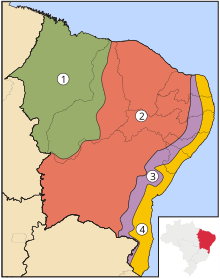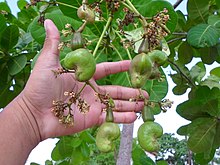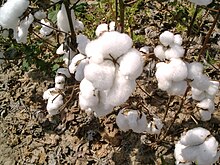Northeast Region, Brazil
Chiefly known as Nordeste ("Northeast") in Brazil, this region was the first to be colonized by the Portuguese and other European peoples, playing a crucial role in the country's history.[citation needed] Nordeste stretches from the Atlantic seaboard in the northeast and southeast, northwest and west to the Amazon Basin and south through the Espinhaço highlands in southern Bahia.For many years, sugar cane cultivation in this region was the mainstay of Brazil's economy, being superseded only when coffee production developed in the late 19th century.In Brazil, the geographical term referred to backlands away from the Atlantic coastal regions where the Portuguese first settled in South America in the early sixteenth century.[6] Because of this vulnerability to the climate, Sertão is also known as a “polygon of drought.”[7] Due to global warming, more frequent, more severe and longer droughts are estimated to hit the region over the next 90 years.The easterly trade winds blow across the region and bring abundant rainfall to the coast but producing clear, dry conditions inland where the escarpment blocks moisture flow.[16][18] It was the first area of Brazil to be colonized when roughly 1,500 Portuguese arrived on April 22, 1500, under the command of Pedro Álvares Cabral at Porto Seguro, in what is now the state of Bahia.The coast of Nordeste saw the first economic activity of the country, namely the extraction and export of pau Brasil, or brazilwood.Brazilwood was highly valued in Europe where it was used to make violin bows (especially the Pau de Pernambuco variety) and for the red dye it produced.Countries like France, which disagreed with the Treaty of Tordesillas (a papal bull decreed by the Spanish-born Pope Alexander VI in 1493 which sought to divide South America between the Spanish and the Portuguese), launched many attacks on the coast to steal the wood.After resistance from indigenous peoples and opposition to their enslavement from the Jesuits,[19] the Portuguese colonials began importing black African slaves in 1530, largely to Bahia.The Dutch, also opposed to the Treaty of Tordesillas, plundered Nordeste's coast, sacked Bahia in 1604, and even temporarily captured Salvador, which had been Brazil's first capital and general seat of government since 1549.The colonists of the Dutch West India Company (WIC) in Brazil were under constant siege despite the presence in Recife of John Maurice of Nassau as governor.The Quilombo dos Palmares, the largest and most well-known of these settlements, was founded around 1600 in the Serra da Barriga hills, in the present state of Alagoas.Following the ban, some slaves from Nordeste were sold to the Southeast region of Brazil (Portuguese: Sudeste), primarily to the state of Rio de Janeiro.[32] The region is a major producer of cashew nuts, sugar cane, cocoa, cotton and tropical fruits in general (mainly coconut, papaya, melon, banana, mango, pineapple and guarana).However, the sector has been suffering strong competition and losing market to Indonesia, the Philippines and India, the world's largest producers, who even export coconut water to Brazil.It is estimated that at 295 thousand tons per year the installed capacity for processing cashew nuts in the Northeast, however, the Region only managed to produce around a quarter of that quantity.[55][56][57][58] In the extraction of precious and semi-precious stones, Bahia has small or medium scale productions of amethyst, agate, diamond, emerald, garnet, opal, ruby, tourmaline and turquoise.Bahia has 4.4% of the national industrial GDP,[59] Pernambuco 2.7%,[60] Ceará 1.9%,[61] Maranhão 1.1%,[62] Rio Grande do Norte 0.9%,[63] Paraíba 0.7%,[64] Sergipe 0.6%,[65] Alagoas 0.5%[66] and Piauí 0.4%,.In Pernambuco, the naval, automobile, chemical, metallurgical, flat glass, electro-electronic, non-metallic minerals, textile and food industries stand out.The state capital is home to Porto Digital, a technology park with more than 200 companies, including multinationals such as Accenture, Oracle, ThoughtWorks, Ogilvy, IBM and Microsoft, accounting for 3.9% of Pernambuco's GDP.[70] Some of the large companies in Ceará with national reach are: Aço Cearense (steel), Companhia de Alimentos do Nordeste (food), Grendene (footwear), Café Santa Clara (coffee), Grande Moinho Cearense (mill), Edson Queiroz Group (business conglomerate, works with gas, mineral water, household appliances, communications, education, among others), Naval Industry of Ceará, J. Macêdo, M. Dias Branco (food company that manufactures, markets and distributes cookies, pasta, cakes, snacks, wheat flour, margarine and vegetable fats), Troller and Ypióca.Most coastal cities of Nordeste, besides the capital cities, have natural amenities, such as the Abrolhos Marine National Park, Itacaré, Comandatuba Island, Costa do Sauípe, Canavieiras and Porto Seguro, in the state of Bahia; the Marine National Park of Fernando de Noronha, Porto de Galinhas beach in the state of Pernambuco; tropical paradises, such as Canoa Quebrada and Jericoacoara, on the coast of Ceará, as well as places to practice paragliding, as in Quixadá and Sobral; and Lençóis Maranhenses, embellishing the coast of Maranhão State, among many others.Paulo Roberto Costa, its downstream director, envisages trains transporting soybeans, corn, and iron ore from the interior to the ports, and returning with oil.[citation needed] The north–south railway and the Carajás railray in Maranhão are important logistics corridors, transporting the iron ore from the Serra dos Carajás in Pará and draining the agricultural production (soybeans, corn, cotton) of southern Maranhão, Tocantins, Goiás and Mato Groso, to the ports of Itaqui and Ponta da Madeira, in São Luís.The results, published by the scientific American Journal of Human Biology by a team of the Catholic University of Brasília, show that, in Brazil, physical indicators such as colour of skin, eyes and hair have little to do with the genetic ancestry of each person, which has been shown in previous studies (regardless of census classification).In this work we analyzed the information content of 28 ancestry-informative SNPs into multiplexed panels using three parental population sources (African, Amerindian, and European) to infer the genetic admixture in an urban sample of the five Brazilian geopolitical regions."[84] An autosomal DNA study from 2009 found a similar profile "all the Brazilian samples (regions) lie more closely to the European group than to the African populations or to the Mestizos from Mexico.[89] A study from 1965, "Methods of Analysis of a Hybrid Population" (Human Biology, vol 37, number 1), led by the geneticists D. F. Roberts e R. W. Hiorns, found out the average the Northeastern Brazilian to be predominantly European in ancestry (65%), with minor but important African and Native American contributions (25% and 9%).As Nordeste is mostly arid or semi-arid, the Northeasters give thanks to Saint John for the rainfall that typical falls this time of year, which greatly helps the farmers with their crops.
1 • Meio-Norte
2 • Sertão
3 • Agreste
4 • Zona da Mata






















Nordeste municipalityNordeste (socio-geographic division)RegionCountryBrazilRecifeSalvadorFortalezaStatesAlagoasCearáMaranhãoParaíbaPernambucoPiauíRio Grande do NorteSergipeLife expectancyInfant mortalityLiteracyTime zonesPortugueseregions of the countryBrazilian Institute of Geography and StatisticsFernando de Noronhathe country's historyAtlantic seaboardAmazon BasinEspinhaçoSão Francisco Riverdrainage basintropical zoneCaatingaAtlantic ForestCerradoecoregionssemi-aridhydricSão LuísSertãoAgresteZona da MatadeforestationBrazil's economycoffeeSugar canetrade windsCaruaruCampina GrandeArapiracabackcountryoutbackLusitanian explorersBrazilian HighlandsPlanalto da BorboremaSerra da IbiapabaMinas GeraisSouth Atlantic OceanIntertropical Convergence Zonedroughtglobal warmingAntônio CalladoAmazon rainforestsemi aridSão FranciscoCanindéParnaíba RiverscratonTocantins RiverThe Great EscarpmentColonial BrazilHistory of BrazilTupi–GuaraniPedro Álvares CabralPorto SeguroOlindaUNESCO World Heritage SitebrazilwoodPau de PernambucoFranceTreaty of TordesillasPope Alexander VIJesuitsAfrican slavesRio de JaneiroFrance AntarctiqueFrance EquinoxialeEuropeDutch West India CompanyJohn Maurice of NassauDutch BrazilSalvador, BahiaquilombosQuilombo dos PalmaresSerra da BarrigaPalmaresZumbi dos Palmaresking of PortugalMarquis of PombalEusébio de Queirós LawSoutheast region of BrazilGreat DroughtAmazonWar of CanudosCangaceirosJuscelino KubitschekSuperintendency for the Development of the NortheastPopulist Republicmilitary dictatorshipindustrializationStates of BrazilMunicipalitiesPopulationGDP per capitaLargest Cities of Northeast Region, BrazilMunicipalities of BrazilJoão PessoaMaceióTeresinaAracajuEconomy of BrazilAgriculture in BrazilMining in BrazilIndustry in BrazilLuís Eduardo MagalhãesIlhéus


